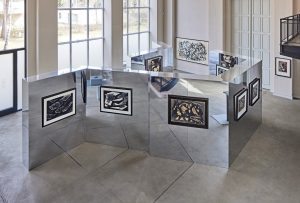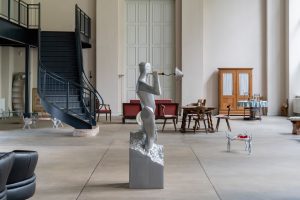Two artists, one theme – when Wolf Vostell (1932–1998) and Boris Lurie (1924–2008) met in the 1960s, they soon shared more than friendship. Both adopted political positions with their art, both contended with the reappraisal of the inconceivable horrors of the Holocaust, and both opposed war, cruelty and crimes against humanity with every means at…
 Image: View of the exhibition “Spatial Lines – Graphic works by Hans Uhlmann 1933–1960”, Kunsthaus Dahlem, 2022. © Kunsthaus Dahlem. Photographer: Gunter Lepkowski.
Image: View of the exhibition “Spatial Lines – Graphic works by Hans Uhlmann 1933–1960”, Kunsthaus Dahlem, 2022. © Kunsthaus Dahlem. Photographer: Gunter Lepkowski.
The exhibition »Spatial Lines: Graphic Works by Hans Uhlmann, 1933–1960« pays tribute to one of the prominent artists in West Germany after 1945. Known above all as a sculptor, this exhibition now concentrates on his graphic work. The occasion for this retrospective exhibition is the publication of Uhlmann’s prison diaries, which are both an intimate…
Marta Dyachenko (*1990 in Kyjiw, Ukraine) studierte Architektur und Bildende Kunst mit dem Schwerpunkt Bildhauerei an der Universität der Künste Berlin bei Manfred Pernice. In ihren Installationen arbeitet sie häufig mit modellhaften Skulpturen in der Landschaft. Dabei spielt die Beschäftigung mit dem Verhältnis von Natur und Mensch und dem gesellschaftlich konstruierten Blick auf Landschaft eine…
 »Henrike Naumann – Einstürzende Reichsbauten«, 2021, exhibition view, Berlin, Kunsthaus Dahlem. Photo: Moritz Jekat; courtesy Henrike Naumann and KOW Berlin
»Henrike Naumann – Einstürzende Reichsbauten«, 2021, exhibition view, Berlin, Kunsthaus Dahlem. Photo: Moritz Jekat; courtesy Henrike Naumann and KOW Berlin
Beginning in the spring of 1933, the National Socialists were manifesting their newly acquired claim to power on all levels. An important aspect of this was penetrating society, even into private space. This not only meant idealizing conservative gender roles and images of the family or introducing »Heil Hitler« as an everyday greeting and the…
The competition for the »Monument to the Unknown Political Prisoner« was probably the most important art competition of the post-war period. More than 3,000 artists from all over the world participated, including sculptors and architects such as Max Bill, Alexander Calder, Naum Gabo, Barbara Hepworth, and Bernhard Heiliger. Like no other competition after 1945, it…